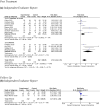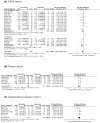Effectiveness of Psychotherapy for Internalising Symptoms in Children and Adolescents When Delivered in Routine Settings: A Systematic Review and Meta-analysis
- PMID: 37059918
- PMCID: PMC10465434
- DOI: 10.1007/s10567-023-00433-8
Effectiveness of Psychotherapy for Internalising Symptoms in Children and Adolescents When Delivered in Routine Settings: A Systematic Review and Meta-analysis
Abstract
This systematic review and meta-analysis aimed to examine the effectiveness of psychological interventions for internalising disorders in youth when delivered in routine settings. Secondary aims were to examine the effectiveness of cognitive behavioural therapy and determine moderators of treatment response. The study was pre-registered (PROSPERO 2020 CRD42020202776). Databases were systematically searched (PsycINFO, Medline, Embase, PubMed, ERIC) in December 2022 and screened according to the PRISMA 2020 statement. Inclusion: School aged participants (4-18 years) with a primary internalising disorder; psychotherapy delivered in a routine setting (e.g. outpatient clinic, school) by setting staff; compared psychotherapy to any control in a randomised controlled trial; reported pre-to-post or pre-to-follow-up comparisons on the primary disorder according to child, parent or independent evaluator report; and was published in English. Risk of bias was assessed using the ROB 2.0 Cochrane tool. Results were synthesised using random effects to pool estimates. Risk ratios were used to analyse dichotomous data and standardised mean differences (SMD) for continuous data. Forty-five studies were included (N = 4901 participants; M = 13 years; range 8-16; SD = 2.5). Nine used waitlist control, 17 treatment as usual, 4 placebo; 15 compared psychotherapy to active control. Psychotherapy was associated with small significant effects pre- to post-treatment compared to non-active controls for anxiety (SMD = - 0.24 to 0.50) and depression (SMD = - 0.19 to 0.34) with effects differing by informant. Psychotherapy led to small significant pre-to-post-benefits in youth internalising disorders in routine settings. Results are limited by reporter type and follow-up.
Keywords: Anxiety; Depression; Effectiveness; Meta-analysis; Systematic review; Youth.
© 2023. The Author(s).
Conflict of interest statement
The authors report there are no competing interests to declare.
Figures











Similar articles
-
Psychological therapies for the treatment of mental disorders in low- and middle-income countries affected by humanitarian crises.Cochrane Database Syst Rev. 2018 Jul 5;7(7):CD011849. doi: 10.1002/14651858.CD011849.pub2. Cochrane Database Syst Rev. 2018. PMID: 29975811 Free PMC article.
-
E-Health interventions for anxiety and depression in children and adolescents with long-term physical conditions.Cochrane Database Syst Rev. 2018 Aug 15;8(8):CD012489. doi: 10.1002/14651858.CD012489.pub2. Cochrane Database Syst Rev. 2018. PMID: 30110718 Free PMC article.
-
Control interventions in randomised trials among people with mental health disorders.Cochrane Database Syst Rev. 2022 Apr 4;4(4):MR000050. doi: 10.1002/14651858.MR000050.pub2. Cochrane Database Syst Rev. 2022. PMID: 35377466 Free PMC article.
-
Psychological therapies versus antidepressant medication, alone and in combination for depression in children and adolescents.Cochrane Database Syst Rev. 2012 Nov 14;11:CD008324. doi: 10.1002/14651858.CD008324.pub2. Cochrane Database Syst Rev. 2012. Update in: Cochrane Database Syst Rev. 2014 Nov 30;(11):CD008324. doi: 10.1002/14651858.CD008324.pub3. PMID: 23152255 Updated.
-
Psychological and/or educational interventions for the prevention of depression in children and adolescents.Cochrane Database Syst Rev. 2004;(1):CD003380. doi: 10.1002/14651858.CD003380.pub2. Cochrane Database Syst Rev. 2004. Update in: Cochrane Database Syst Rev. 2011 Dec 07;(12):CD003380. doi: 10.1002/14651858.CD003380.pub3. PMID: 14974014 Updated.
Cited by
-
Systematic review and meta-analysis of psychological interventions for depression symptoms in young people with long-term physical health conditions.J Pediatr Psychol. 2025 Jul 1;50(7):699-714. doi: 10.1093/jpepsy/jsaf049. J Pediatr Psychol. 2025. PMID: 40795045 Free PMC article.
-
Promoting the mental health and well-being of vulnerable youth through art: an ethnographic evaluation of an art-based intervention for rural Canadian youth.BMC Psychol. 2025 Mar 3;13(1):182. doi: 10.1186/s40359-025-02476-8. BMC Psychol. 2025. PMID: 40025614 Free PMC article.
-
Scoping review: outpatient psychotherapeutic care for children and adolescents in Germany-status quo and challenges in assessment.Front Public Health. 2025 Feb 17;13:1480630. doi: 10.3389/fpubh.2025.1480630. eCollection 2025. Front Public Health. 2025. PMID: 40034167 Free PMC article.
-
The Integration of Psychophysiological Interventions with Psychotherapy and Pediatrics.Appl Psychophysiol Biofeedback. 2025 Jun;50(2):297-304. doi: 10.1007/s10484-025-09695-0. Epub 2025 Apr 4. Appl Psychophysiol Biofeedback. 2025. PMID: 40183880 Free PMC article.
-
Family Support Protocol for Adolescent Internalizing Disorders: Protocol for a Pre-Post Quantitative Treatment Development Study.JMIR Res Protoc. 2024 Sep 16;13:e64332. doi: 10.2196/64332. JMIR Res Protoc. 2024. PMID: 39284179 Free PMC article.
References
-
- American Psychiatric Association. (2000). Diagnostic and statistical manual of mental disorders (4th ed., text rev.). American Psychiatric Association. 10.1176/appi.books.9780890420249.dsm-iv-tr
-
- American Psychiatric Association. (2013). Diagnostic and statistical manual of mental disorders (5th ed.). American Psychiatric Association. 10.1176/appi.books.9780890425596
Publication types
MeSH terms
LinkOut - more resources
Full Text Sources

